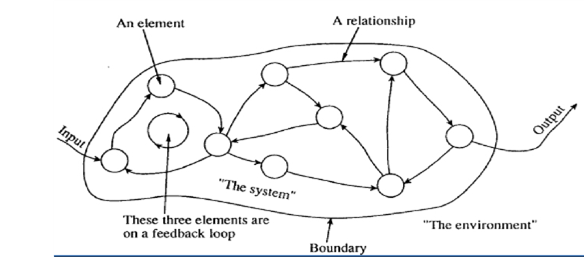TOPIC 2.13: Performance evaluation and innovation
Recommended
30 mins
Back to our concept of ‘bricolage’ – being resourceful, frugal and innovative – evaluation and learning with cross-sector, cross-boundary partners provides opportunities for continuous improvement and social innovation.
A basic system thinking approach to evaluation as shown in Figure 2.2 below, includes identifying:
- the resources used (inputs, stakeholders)
- what is done (processes, throughput, quality)
- what is produced (outputs)
- what impacts are achieved (outcomes, benefits and for whom).

Figure 2.2: System Boundaries (Source: Flood & Jackson, 1991)[1]
Performance information addresses the relationships between these elements. It should provide sufficient information to answer the questions about key aspects of performance such as:
- How effective is the program in achieving the desired outcome?
- How efficient is it in using inputs to produce required outputs?
- What is the quality of the program’s outputs and outcomes – that is, are clients/ stakeholders/ citizens receiving a satisfactory level of service?
- Is the program meeting access and equity requirements?
The Report on Government Services (ROGS) compares public service delivery across a range of parameters. The Productivity Commission’s Report on Government Service Provision is published annually.
In Module 5, we will consider the contestability process, an attempt by government to compare and contrast the price and quality of government service provision with credible alternatives. The process of creating benchmarks for service quality comparison and to drive innovation, productivity and competition includes interstate comparisons as well as local and global cross sector comparisons.
In this Module, we have explored:
|
|
We have suggested that managing outwards represents a different way of working in the cross-sector, cross-boundary world of government systems activity. Accountability is linked to negotiated agreements with diverse actors over whom there is little leverage or direct control. Accountability models will be further explored in Module 4.
We have explored different forms of collaboration within and across the system of government including contractual relationships and network management approaches.
Recommended
30 mins
See the most recent Report on Government Services (ROGS) for an inter-state comparison of public service delivery across a range of parameters.
Compare your state’s service performance with another state.
- Where are you leading and where are you lagging?
- How may the differences be explained?
Next steps
In the next module, we will focus on strength-based approaches, including Appreciative Inquiry, to build collaborative practice and to inform government service delivery.
Working towards Assessment One
- Revisit your rich picture(s) –from the recommended sections of this module – and reflective activities from Modules 1&2.
- Select the specific relationship you will analyse using frameworks and concepts in modules 1 and 2.
- Begin to analyse the relationship now.
Refer to the Assessment Task 1 details on the Unit site to refresh your memory of the assessment requirements.
- Flood & Jackson. (1991). Creative problem solving. John Wiley and Sons, Chichester ↵

